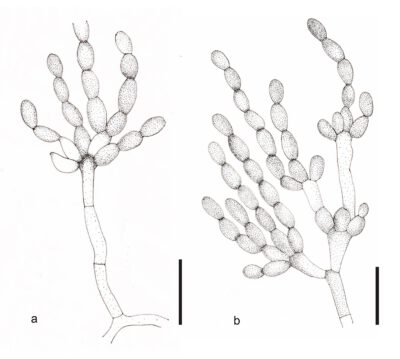Fungalpedia – Note 276, Fuscoannellis
Fuscoannellis Sand.-Den., Jagielski, Jin Yu & Gené
Citation when using this entry: Perera et al. 2024 (in prep) – Fungalpedia, genera described in 2016.
Index Fungorum, Facesoffungi, MycoBank, GenBank, Fig. 1
Classification: Microascaceae, Microascales, Hypocreomycetidae, Sordariomycetes, Pezizomycotina, Ascomycota, Fungi
Jagielski et al. (2016) described the monotypic genus Fuscoannellis, which is typified by scopulariopsis-like taxon Scopulariopsis carbonaria. Fuscoannellis species occur on unidentified pyrenomycetes, dead hardwood, and soil (Jagielski et al. 2016; Woudenberg et al. 2017). The genus is characterized by moderately spreading colonies that are greenish grey, dark grey to black, and velvety to funiculose. The conidiophores are either unbranched or branched. Unbranched conidiophores terminally bear a compact group of 2–10 conidiogenous cells. Branched conidiophores are more frequent, with several stages of branching, each branch terminally swelling and bearing a compact group of conidiogenous cells. Conidiogenous cells are annellidic, pale brown to brown and smooth-walled. They are mostly ampulliform, with a swollen base and an annellated zone that never greatly elongates. Conidia are aseptate and ovate, with a rounded or slightly pointed apex and a wide truncate base, and arranged in long basipetal dry chains that often adhere to fairly dense columns. Conidia are smooth-walled, brown or greyish brown, and close to black in mass. The sexual morph remains undetermined. However, Fuscoannellis was synonymized with Yunnania (Microascaceae) by Woudenberg et al. (2017), based on phylogenetic analysis of ITS, LSU, and tef1 markers.
Type species: Fuscoannellis carbonaria (F.J. Morton & G. Sm.) Sand.-Den., Jagielski, Jin Yu & Gené
Other accepted species: The genus is monotypic
Figure 1 – Fuscoannellis carbonaria (CBS 205.61, ex-type culture). a, b Simple and branched conidiophores and conidia. Scale bars: a, b = 10 μm. Redrawn from Jagielski et al. (2016).
References
Entry by
Rekhani Hansika Perera, Center of Excellence in Fungal Research, Mae Fah Luang University, Chiang Rai, 57100, Thailand.
(Edited by Kevin D. Hyde, Samaneh Chaharmiri-Dokhaharani, & Achala R. Rathnayaka)
Published online 28 May 2024
